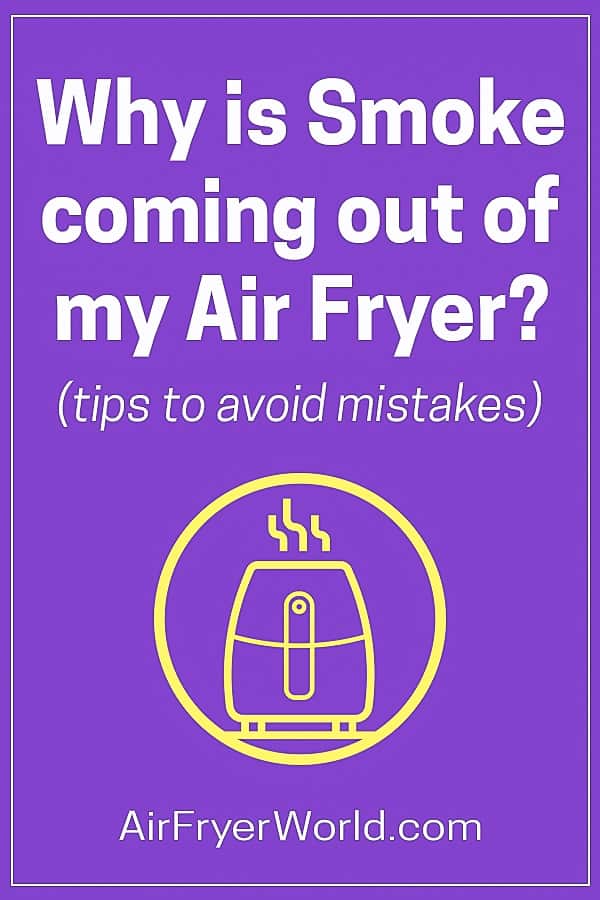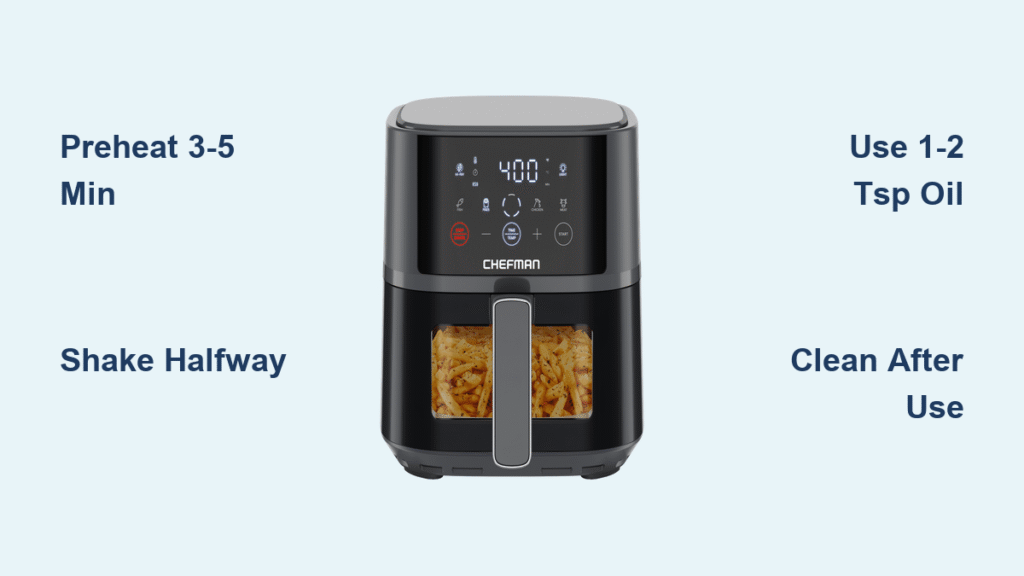Tired of waiting forever for your oven to preheat or dealing with messy oil splatters from deep frying? Your Chefman air fryer solves both problems with rapid, even cooking that creates crispy exteriors using just a fraction of the oil. Whether you’re unboxing your first model or looking to master advanced techniques, this guide walks you through everything you need to know to get perfect results every time.
You’ll discover exactly how to load food properly, which temperatures work best for different foods, and the simple tricks professionals use to achieve restaurant-quality results. Stop guessing and start cooking with confidence—let’s transform your weeknight dinners with this versatile kitchen essential.
First-Time Setup Essentials for Perfect Operation
Remove All Packaging Materials Completely
Take everything out of the box and remove every piece of plastic film, foam inserts, and protective stickers. These small pieces can melt or create unpleasant odors if left inside during cooking. Check all crevices of the basket and crisper tray—manufacturers often place protective films directly on the non-stick surfaces that aren’t immediately visible.
Choose the Right Location for Safety and Performance
Place your Chefman air fryer on a heat-resistant surface with 5 inches of clearance on all sides. This ensures proper ventilation and prevents heat damage to nearby surfaces. Avoid placing under cabinets or near curtains that could be damaged by heat. Critical safety note: Never operate your air fryer on soft surfaces like beds or couches where vents could become blocked.
Clean Before First Use Properly
Wash the removable basket and crisper tray in warm, soapy water using a non-abrasive sponge. Use a damp cloth to wipe down the interior walls and exterior surfaces. Never submerge the main unit—simply wipe it clean. Dry all components completely before reassembling, as moisture can cause steam issues during your first cooking session.
Run Initial Test Cycle to Eliminate Manufacturing Residues
Set your empty air fryer to 400°F for 10 minutes to burn off any manufacturing residues. You’ll notice some smoke or odors during this first run—this is completely normal. Open windows for ventilation and run your kitchen fan during this process. Let the unit cool completely before cooking your first meal.
Basic Operation Steps You Need to Know
Power On Your Unit Correctly
Plug your Chefman air fryer into a dedicated electrical outlet—never use an extension cord. The digital display will illuminate when properly connected. Most North American models require 120V power supply, so verify your model matches your local electrical standards before first use.
Load Food for Optimal Air Circulation
Pull the basket straight out and place food in a single layer for proper air circulation. The maximum capacity ranges from 3.5-5 quarts depending on your model. Never exceed the MAX fill line marked inside the basket—overcrowding causes uneven cooking. Pro tip: Use the crisper tray at the bottom for foods that release oil or need drainage.
Set Temperature and Time Precisely
Use the +/- buttons to adjust temperature from 200°F to 400°F in 5-degree increments. Set the timer between 1-60 minutes based on your recipe. Important: Most foods cook 20% faster than conventional ovens, so start checking for doneness earlier than expected.
Start Cooking for Best Results
Insert the basket until it clicks into place. Press the power/start button to begin cooking. Preheating for 3-5 minutes improves results significantly, especially for foods needing immediate high heat like frozen items or steaks. The fan starts immediately, circulating superheated air around your food.
Temperature Guide for Perfect Results Every Time

200°F: Dehydrating Mode for Nutrient Preservation
Perfect for making dried fruit chips or gently reheating delicate leftovers. This low temperature preserves nutrients while removing moisture. Ideal for herbs, banana chips, or jerky—cut foods into ¼-inch slices and expect 2-8 hours cooking time.
350°F: The Sweet Spot for Vegetables and Fish
The ideal temperature for Brussels sprouts, salmon fillets, or reheating fried foods. Creates crispy edges without overcooking centers. Toss vegetables with just 1 teaspoon oil and your favorite seasonings for best results.
375°F: Chicken and Frozen Foods Success Zone
Works perfectly for chicken wings, frozen french fries, or breaded cutlets. High enough to crisp the exterior while cooking through completely. Critical safety tip: Always verify chicken reaches 165°F internal temperature with a food thermometer.
400°F: Maximum Crisp Mode for Restaurant-Quality Results
Use for steaks, bacon, or any foods needing serious crunch. Monitor closely as foods can burn quickly at this temperature. Pro technique: Shake basket every 3-5 minutes for even browning without flipping delicate items.
Cooking Techniques Professionals Use
Master the Shake Technique for Even Cooking
Pull the basket out completely halfway through cooking—your Chefman air fryer pauses automatically. Shake gently or flip food with silicone-tipped tongs to avoid scratching the non-stick surface. Most foods need shaking every 5-10 minutes, but frozen items require more frequent attention.
Oil Application Secrets for Perfect Crispiness
Most foods need little to no oil. When you do use oil, apply just 1-2 teaspoons using a pump spray bottle or pastry brush. Never use aerosol sprays with propellants—they damage the non-stick coating over time. Focus oil application on top surfaces for maximum crispiness.
Troubleshooting Common Problems Quickly

Food Not Crispy? Fix These Three Issues
Increase temperature by 25°F for better browning, ensure food is completely dry before cooking (pat proteins with paper towels), and never overcrowd the basket. For frozen items, reduce package oven temperature by 25°F but increase cooking time by 5-10 minutes.
Smoking Air Fryer? Immediate Solutions
Clean interior thoroughly to remove oil buildup, reduce oil usage for next cooking session, and ensure proper ventilation around the unit. Critical check: Verify you’re not using aerosol cooking sprays that damage the non-stick coating.
Basket Stuck? Safe Removal Method
Ensure unit is completely cool, then check for food debris in the tracks. Gently wiggle the basket while pulling straight out—never force it. Prevent future issues by cleaning tracks weekly with a soft brush.
Cleaning and Maintenance for Longevity
Daily Cleaning Routine That Takes Just 5 Minutes
Unplug and let cool for 30-45 minutes. Remove basket and crisper tray—these are dishwasher safe on the top rack. Use non-abrasive sponges and mild detergent. Dry completely before reassembling to prevent moisture buildup.
Deep Cleaning Process for Stubborn Residue
For baked-on food, soak basket in hot, soapy water for 10-15 minutes. Use baking soda paste (3 parts baking soda to 1 part water) for tough stains. Clean the heating element area carefully with a soft brush—never use metal scrubbers.
Quick Reference Chart for Instant Success
Ready-to-Use Cooking Times and Temperatures
- Frozen Fries: 400°F, 15-18 minutes, shake every 5 minutes
- Chicken Wings: 375°F, 20-25 minutes, flip halfway
- Salmon Fillet: 400°F, 8-10 minutes, skin-side down
- Brussels Sprouts: 375°F, 12-15 minutes, shake twice
- Mozzarella Sticks: 390°F, 6-8 minutes, watch closely
- Bacon: 400°F, 8-12 minutes, check at 6 minutes
Recipe Conversion Guide for Perfect Results
Reduce conventional oven temperature by 25°F and cooking time by 20%. Always check for doneness 5-10 minutes early and adjust based on visual cues rather than strict timing. Your Chefman air fryer transforms weeknight cooking into quick, healthy meals with less oil and mess than traditional methods. Start with these basics, then experiment with your favorite recipes—you’ll discover this versatile appliance can handle everything from breakfast bacon to dinner desserts. The key to mastery? Consistent practice with proper techniques—your perfect crispy results are just one cook away.



